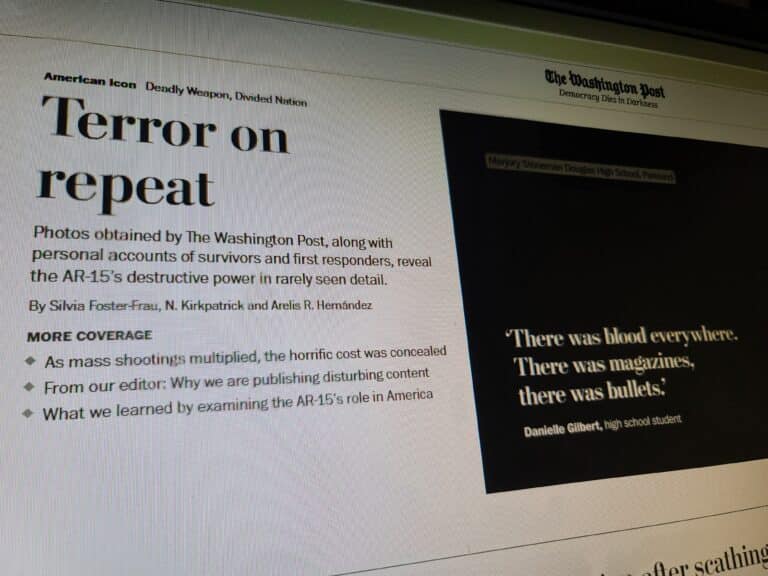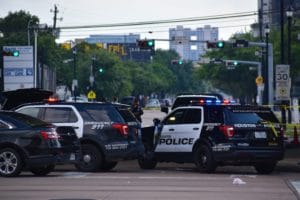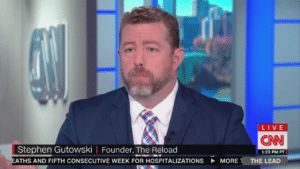There are many problems with The Washington Post’s decision to publish gory scenes of mass murder.
On Thursday, The Washington Post published a piece titled “Terror on Repeat: A rare look at the devastation caused by AR-15 shootings,” which features a number of graphic pictures of the aftermath of a select number of mass killings. We aren’t going to link to it here, but it is in front of the publication’s paywall and on the front page of their website. So, it isn’t hard to find.
The images are as awful as you’d expect. They feature the bloody aftermath of at least 11 mass killings. One features body bags lining the hallway of Robb Elementary School in Uvalde, Texas. Another shows a Las Vegas field strewn with uncovered dead bodies. They certainly show how horrendous mass murder can be.
Sally Buzbee, the paper’s editor, justified publishing the pictures with the claim that most Americans don’t understand the violence of attacks carried out by somebody with an AR.
“Like other news organizations, we cover the effects of these tragedies when they occur,” Buzbee wrote. “But because journalists generally do not have access to crime scenes and news organizations rarely if ever publish graphic content, most Americans have no way to understand the full scope of an AR-15’s destructive power or the extent of the trauma inflicted on victims, survivors and first responders when a shooter uses this weapon on people.”
Frankly, it’s difficult to see how this thin reasoning couldn’t be used to justify publishing pictures or videos of any disturbingly violent act. That’s a significant departure from how reputable news outlets have long operated. Usually, images of graphic violence are only published in an effort to document incidents like war crimes, such as the recent Russian massacre in Bucha, Ukraine, or terror attacks, like the October 7th raids in Israel. It’s generally done to prevent bad actors, especially despotic governments or terror groups, from claiming the events didn’t happen or were carried out by other people. Or, at the very least, to demonstrate the evils the organized attackers are willing to employ in an ongoing campaign.
Newspaper editors haven’t traditionally viewed the shock value of gory images as newsworthy in and of itself.
The premise that Americans are unaware of the graphic nature of mass killings is also highly questionable, especially in 2023. It’s honestly difficult not to come across uncensored images and auto-playing videos of graphic violence on social media these days, whether it’s in the form of street crime or literal battlefield footage from anywhere in the world.
But, even if you conclude that graphic pictures of mass killings are inherently newsworthy on their own, The Post’s selective publishing of only those involving AR-15s is a bigger problem.
Unfortunately, the aftermath of any mass murder is going to be horrendous. Mass killings in the United States and around the world have been carried out by attackers using every weapon imaginable, including every kind of firearm. The Sante Fe High School shooter murdered ten people with a pump-action shotgun. The Virginia Tech attacker killed 32 with handguns. The University of Texas clock tower killer murdered 18 people primarily with a bolt-action rifle but also a collection of other firearms and a knife, which isn’t uncommon for mass killers. Then there are incidents like the Kyoto Animation arson attack, the Waukesha parade attack, or the University of Idaho stabbings. The weapons used in those, and many other mass killings, range from fire to SUVs to knives. Pictures of the aftermath of those murders would almost certainly be equally distressing to any sane person as the ones The Post published.
The Post’s decision to single out only incidents involving AR-15s is made worse by the way it tried to justify it.
Over the years, The Post has repeatedly claimed there are hundreds of mass shootings per year. In May, they published a piece claiming there had already been more than 200 “mass shootings.” That number is based on the Gun Violence Archive’s broad definition of the term, which includes any incident where four or more people are injured in a shooting. Of course, the vast majority of those “mass shootings” don’t involve AR-15s.
The paper also often reports on what it terms “mass killings,” which are incidents where four or more people are killed. But the majority of those “mass killings,” even ones where the perpetrator used a firearm, don’t involve an AR-15 either.
So, to justify only publishing mass killings where an AR-15 was used, The Post pointed to a new term: “the country’s deadliest mass killings.” It defines this as a shooting where 10 or more people were killed. It reports there have been 18 of those since 2012, and ten involved an AR-15. But The Post seems to have strayed outside even its “deadliest mass killings” definition because it includes pictures and quotes from at least two other shootings that don’t fit its standard.
Regardless, The Post apparently felt it had reason enough to ignore pictures from the eight other “mass killings” of this severity and the hundreds of other “mass shootings” they report happen each year in order to focus exclusively on the AR-15.
The Post’s approach leaves readers with a false impression that the pictures it published represent scenes that play out hundreds of times per year AND only happen because of some unique ability of the AR-15. The truth is most “mass shootings,” as defined by the Gun Violence Archive, don’t look like the ones in the pictures AND the ones that do have been carried out with a variety of different weapons.
The Post’s decision to selectively publish pictures of mass murders this way is likely the result of a common frustration shared by gun-control advocates and many reporters. They often react to the reality that not everyone supports stricter gun laws with the question, “What will it take?” It’s a question often asked explicitly in interviews about mass shootings and implicitly in the way many stories on guns are framed.
These pictures were published with that question in mind. In fact, an editorial published alongside The Post’s expose makes the intention crystal clear.
“A responsible newspaper does not publish such upsetting images lightly, but doing so showcases the destructive force of the AR-15 in a way words fail to do,” the editors wrote. “About 1 in 20 U.S. adults, roughly 16 million people, own at least one AR-15. Two-thirds of these were manufactured in the past decade. Just as there is no excuse for the widespread availability of these weapons of war, there is no legitimate purpose for civilians to be able to fire so many rounds with one pull of the trigger.”
The assumption that underrides a lot of major media reporting on guns in America is that countries who’ve effectively banned, or at least severely restricted, civilian gun ownership have made the correct calculation, and America will, or at least should, eventually do the same. Opposition to such policies is commonly assumed to either be based on ignorance, which can perhaps be combatted by showing people graphic images of gun violence, or callousness. Little consideration is given to the much more common view among gun owners that gun bans won’t solve the underlying problem and will, instead, leave them without a means to protect themselves.
It’s more than fair to evaluate and challenge the actual views gun owners hold. It’s fair to question past norms about publishing graphic images.
In fact, there may be times when it is important for adults to witness the aftermath of awful attacks. Most editors likely agree that’s the case with incidents like Bucha or October 7th. Although, usually, that’s done to get an understanding of what the perpetrators were willing to do to their victims rather than an examination of the particular weapons they used. This is a less fruitful exercise when it comes to most mass shooters because they tend to be people motivated by a specific kind of mental health spiral and less by the ideological, political, or national goals that motivate armies or formal groups. There is less to be learned by the violent lengths an individual mass killer is willing to go to since they don’t pose a continuing, organized threat.
But that point could at least be argued. What’s less arguable is The Post’s decision to distribute the awful aftermath of mass killings only if their perpetrators used a certain kind of weapon.
The paper doesn’t indicate it is attempting to examine the motivations or tactics by publishing the images. Instead, it emphasizes the point is to present readers with pictures of selectively chosen scenes in order to shock them. And the end goal is to leverage that shock for a particular political outcome: an AR-15 ban.
On top of that, it’s clear at least some of the family members of the victims of these killings were disturbed by the publication of the pictures.
“Please, please do not share the Washington Post,” Kimberly Garcia, who lost her daughter in the Uvalde shooting, wrote on Thursday. “My daughter being taken from this world wasn’t fair to begin with, it’s not fair how she was taken either. Amerie, her classmates, & her teachers don’t deserve this.”
Now, The Post did withhold some, though not all, of the pictures it obtained that had identifiable bodies in them in an effort to lessen the impact on the families. And it’s important to recognize that family members of some victims do want graphic pictures of the shootings to be published. But The Post repeatedly noted the primary reason most publications don’t post these kinds of images is the likelihood that doing so risked “dehumanizing victims or retraumatizing their families.” Understanding the risks, you’d think the paper would make every effort to ensure everyone involved is comfortable with the publication of the pictures if they’re going to post them. But it clearly failed to do that.
Ultimately, though, even if they had gotten everyone on board with publishing the gory images in the first place, it would remain dishonest to only publish those from certain incidents due to political considerations. It misleads readers into thinking mass killings carried out with a knife, 12 gauge shotgun, firebomb, or handgun are easier to stomach than those carried out with an AR-15. That may serve the political goals of The Post’s editors, but it’s a disservice to their readers.







4 Responses
Well said. I find it remarkable that the same news outlets that will print the famous scattergram of gun homicides vs. gun ownership of multiple countries, showing the US as an outlier, will then focus on the AR-15 which would make negligible difference in that chart.
Thank you, Larry. I think a lot of the coverage around gun murder and where AR-15s fit into that topic needs to be improved.
The article says
“There is less to be learned by the violent lengths an individual mass killer is willing to go to since they pose a continuing, organized threat.”
Shouldn’t that say “since they don’t pose …”?
Yes, you’re correct. Thank you for catching that typo. I’ve fixed it.